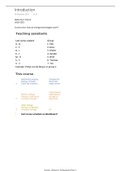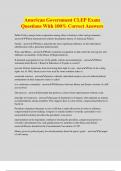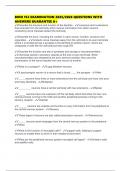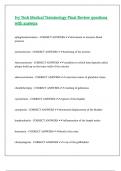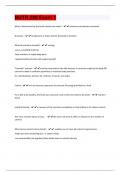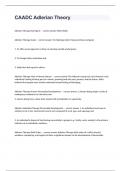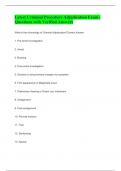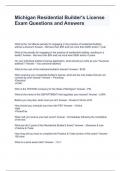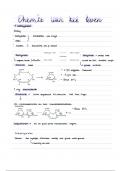05 February 2021 21:51
Notes by Z. Floren
2020-2021
Course aims: how do energy technologies work?
Science of Energy Technologies Page 1
,Lecture 1&2
05 February 2021 21:49
Forms of energy, work and power
What is energy?
Energy is the quantitative property that must be transferred to an object in order to perform work
on, or to heat, the object
• Quantity (has a unit & has a size)
• Conserved (energy cannot be made or destroyed, it can only be converted from one form to
another)
Work = force acting upon + displacement of an object
Heat =
Which units are units of energy?
J (Joule), kg m^2 s^-2 (kinetic E), cal (calorie), kWh
1kWh = 3.6MJ
W = J/s
Edifice of physics
Three layers of physics
1. What physics tells us about the Modern World
○ Why the sun shines (nuclear physics, E=mc^2)
○ Why computers work (quantum physics)
○ Why apples fall from a tree (gravity)
2. Physics
○ Doing the math; understanding and working with the laws
○ SET: Classical Mechanics, Electricity and the Physics of Solar PV
3. How a physicist looks at the world
○ What is the law? What is proportional to what?
○ What are the units?
○ What exactly are we measuring? Approximately how big is it?
Physics -> classical physics + quantum physics + relativity
The chasm of ignorance: we do not know everything, such as quantum gravity, black energy, black
matter, etc.
Physics and our energy sources
• Coal
• Oil
• Gas
• Nuclear
• Hydro
• Biomass & waste
• "New Renewables"
○ Biofuels
○ Wind
○ Solar
○ Tidal
○ Wave
○ Geothermal
Science of Energy Technologies Page 2
,Energy sources, energy use and physics
Law of motion related to hydro, wind, tidal and wave (energy sources), mechanical power (energy
services) and transport (energy sectors)
Fluid mechanics related to hydro, wind, tidal and wave (energy sources), mechanical power (energy
services) and transport and industry (energy sectors)
Electromagnetism related to electricity (E vectors), light (E services), power (E sectors) and solar (E
sources)
Quantum mechanics important to understand PV panels
Fuels -> discussed in Sustainable Energy Supply (3rd year)
What is physics?
Precisely define the fundamental measurable quantities in the universe (e.g. velocity, Ek). The effort
to find the most fundamental description of the universe is a quest that has historically always been
a big part of physics.
Find relationships between those fundamental measured quantities (e.g. Newton's Laws,
conservation of energy, special relativity). These patterns and correlations are expressed using
words, equations, graphs, charts, diagrams, models, and any other means that allow us to
understand them.
Physics is an empirical science. Measurement is the arbiter.
From natural philosophy to the Atomic Age
Empirical science -> everything based on observation
Greeks loved to observe things -> deeply thought about things but did not do measurements ->
ancient natural philosophy
• Epicycle Theory of planetary motion
• Speculation & philosophizing
The Copernican revolution -> put the sun in the middle of the universe instead of the Earth based on
measurements (!)
Before Classical Physics -> medieval ballistics: theory of impetus; the "continuation of motion
depends on continued action of a force"
• Based on observations, not on measurements
Enter Newton: a scientific Revolution, Newton's first law: in the absence of force, a body has a
constant velocity
Science of Energy Technologies Page 3
, constant velocity
• Different from theory of impetus
○ Friction is a force too
• Break between pre-modern Physics and Classical Physics
• Applied mathematics to measurement of nature
○ Founding father of physics
Young - wave theory of light (1803)
• Observed that light behaved as waves too (fundamentally a wave phenomenon)
○ Observed through interference -> required measurements
• Revolutionary insight: Newton had proposed a corpuscular (particle) theory of light
Carnot - thermodynamic efficiency
• Proposed limits on the efficiency on engines
• Applied science with enormous impact in the age of the steam engine
Maxwell - theory of Electromagnetism
• Set of 4 equations that explains an awful lot of physics
• Explains that light is an electromagnetic wave phenomenon
• Combined electric and magnetic field components
At the end of the 1900s, physicists felt like they had explained everything (or at least the most
important things of the world). But there were still some unsolved problems, such as:
• Why does the sun still shine?
• Why is the atom stable?
• Why is there no aether drift?
Science of Energy Technologies Page 4


